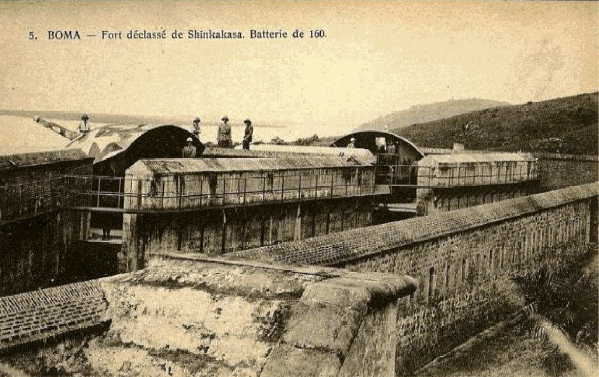Fort de Shinkakasa on:
[Wikipedia]
[Google]
[Amazon]
 The Fort de Shinkakasa, also called Fort Boma, was a fortification built in the Congo Free State to defend access to the
The Fort de Shinkakasa, also called Fort Boma, was a fortification built in the Congo Free State to defend access to the
 The Fort de Shinkakasa, also called Fort Boma, was a fortification built in the Congo Free State to defend access to the
The Fort de Shinkakasa, also called Fort Boma, was a fortification built in the Congo Free State to defend access to the Congo river
The Congo River ( kg, Nzâdi Kôngo, french: Fleuve Congo, pt, Rio Congo), formerly also known as the Zaire River, is the second longest river in Africa, shorter only than the Nile, as well as the second largest river in the world by discharge ...
in 1891. It is located about west of Boma which was the capital of the Free State and later the Belgian Congo
The Belgian Congo (french: Congo belge, ; nl, Belgisch-Congo) was a Belgian colony in Central Africa from 1908 until independence in 1960. The former colony adopted its present name, the Democratic Republic of the Congo (DRC), in 1964.
Colo ...
from 1886 to 1926.
The fort was designed in a two-sided arrow shape by the Belgian engineer Émile Wangermée
Émile Antoine Marie Wangermée (1855–1924) was a Belgian civil servant and vice governor-general of Congo Free State from 11 April 1897 until December 1897.
Wangermée was Representative of the Comité Spécial du Katanga (CSK), effectively ...
who had studied fortress design under General Henri Alexis Brialmont
Henri-Alexis Brialmont (Venlo, 25 May 1821 – Brussels, 21 July 1903), nicknamed The Belgian Vauban after the French military architect, was a Belgian army officer, politician and writer of the 19th century, best known as a military archi ...
. It was built by the Congo Free State to control access to the river, particularly against the Portuguese who occupied nearby Angola
, national_anthem = " Angola Avante"()
, image_map =
, map_caption =
, capital = Luanda
, religion =
, religion_year = 2020
, religion_ref =
, coordina ...
and Cabinda and which it was feared might cut off the Congo Free State from access to the Atlantic Ocean
The Atlantic Ocean is the second-largest of the world's five oceans, with an area of about . It covers approximately 20% of Earth's surface and about 29% of its water surface area. It is known to separate the " Old World" of Africa, Europe ...
. In fact, the confrontation between the two nations were in fact limited to exchanges of fire between light batteries and Portuguese ships.
About two hundred soldiers of the Free State ''Force Publique
The ''Force Publique'' (, "Public Force"; nl, Openbare Weermacht) was a gendarmerie and military force in what is now the Democratic Republic of the Congo from 1885 (when the territory was known as the Congo Free State), through the period of ...
'' occupied the fort where they manned the fort's eight ship guns. In case of emergency, they were supported by local auxiliaries
Auxiliaries are support personnel that assist the military or police but are organised differently from regular forces. Auxiliary may be military volunteers undertaking support functions or performing certain duties such as garrison troops, ...
. The troops of various tribes were assembled there to prevent impending mutinies. They were principally from distant regions to counter any rebellion, such as the Batetela rebellion
The Batetela rebellion (french: Révolte des Batetela) was a series of three mutiny, military mutinies and a subsequent low-level insurgency which was attributed to members of the Tetela people, Tetela ethnic group in the Congo Free State between 1 ...
of 1885–87. Nonetheless, a major mutiny occurred among Tetela soldiers in the fort on 17 April 1900.
Bibliography
* Simon, Eric, ''Le Fort de Shinkakasa'', Bulletin d'information du CLHAM (Centre liégeois d'histoire et d'archéologie militaires), vol X, no. 10, April–June 2009, ISSN 0771-3673 *External links
{{DEFAULTSORT:Fort De Shinkakasa Buildings and structures in the Democratic Republic of the Congo + Military history of the Democratic Republic of the Congo